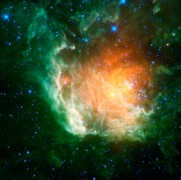The rosebud-like halo surrounding the hot young stars consists of dust that is heated by the stars. The leaf-like green mist embraces the cluster, sealing the ends of the compressed dust cloud. The green substance is composed of hydrocarbon, a substance that can be found on the surface of the earth, in exhaust pipes, barbecue devices, or any other place where combustion occurs

The rosebud-like halo surrounding the hot young stars consists of dust that is heated by the stars. The leaf-like green mist embraces the cluster, sealing the ends of the compressed dust cloud. The green substance consists of hydrocarbon, a substance that can be found on the surface of a car, in exhaust pipes, barbecue devices, or any other place where combustion occurs.
The red sources within the green nebula indicate a second generation of stars forming within the maternity cloud, possibly as a result of heating and compression of the younger stars. The remnants of the supernova NGC 7822 are also in the area, indicating that a massive star erupted and changed the structure of the cloud into its shape. The blue, twinkling dots are older stars in the Milky Way galaxy.
Berkeley59 and NGC-7822 are located in the constellation Cepheus at a distance of about 3300 light years from the Earth.
